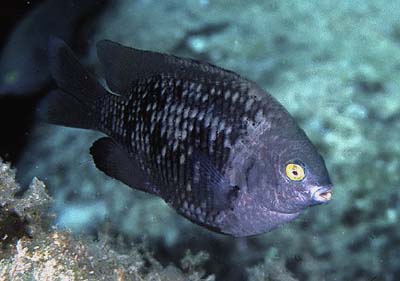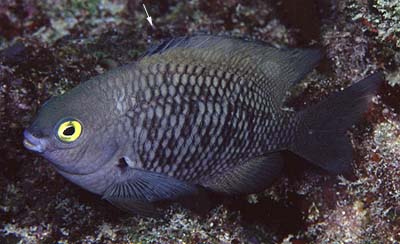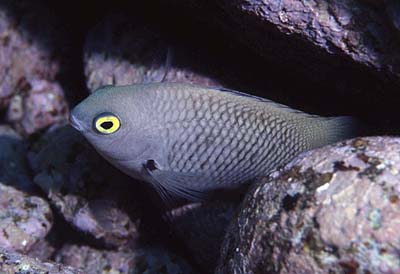| hawaiisfishes.com |
|
Home |
Fishes | Invertebrates |
Books | CDs
| Links |
Contact |
|
past
fishes of the month For the next few months we'll be taking a look at some of common Hawaiian reef fishes which tend to fall under the radar of most snorkelers and divers. Although "beneath notice," they can be quite interesting once you know a little about them. |
 |
| PACIFIC GREGORY Stegastes fasciolatus (Ogilby, 1889) (YELLOW-EYE DAMSEL) This drab, blackish or brownish gray damselfish has bright lemon-yellow eyes and a patchy unkempt appearance due to some scales being lighter than others. Common in Hawai`i, it prefers areas with moderate to low wave activity and feeds primarily on green filamentous algae. Each Pacific Gregory maintains an all-purpose territory (containing shelter and a nesting site as well as food) which it boldly defends against all other algae-eating fishes. The territory extends about 2-4 ft. in all directions from the shelter hole and is usually defined by natural formations such as coral heads or clumps of weed. (Containing more algae than surrounding areas, Pacific Gregory territories are sometimes, but not always, discernible to humans.) Like similar Indo-Pacific and Caribbean damsels, the Pacific Gregory "farms" its patch of filamentous algae by removing undesirable coralline algae. It also eats small invertebrates living in its algal farm. As anyone who has watched a Pacific Gregory for a few minutes can attest, this pugnacious little fish will unfailingly attempt to drive any other herbivore from its algae patch. It does not waste energy by attacking carnivores such as wrasses, but experiments show it can learn to recognize and attack algae-eating fish species it has never seen before. A male Pacific Gregory will also defend its territory against males of its own species. When displaying aggression to another male, it darkens its yellow eyes (see "Oh Those Dark Eyes" below). Juveniles, bluish black with a pale yellow tail, appear during the summer months, often on wave-scoured reef flats. Those under 1 in. have an iridescent blue-purple streak along the top of the head and margin of the dorsal fin. The species name means "banded." To about 6 in. Indo-Pacific, but with a slightly different color pattern in Hawai`i (see "Three Color Patterns" below). Pomacentrus jenkinsi is a synonym. Photo: Pupukea, O`ahu. 15 ft. |
|
|
|
A
"KEYSTONE SPECIES" |
|
OH
THOSE DARK EYES |
 |
| THREE
COLOR PATTERNS Like many Hawaiian fishes, local Pacific Gregories have a slightly different color pattern than Pacific Gregories elsewhere. Although the basic blackish color remains the same, outside Hawai`i these fish have pale blue to lavender spots on the head, breast, and at the base of the anal fin. In the Western Indian Ocean they also exhibit yellow on the rear of the dorsal, anal and tail fins. By contrast, adult Hawaiian specimens lack blue spots and yellow fins, having instead a distinctive black mark between the 1st and 3rd dorsal spines (see arrow). Differences such as these might in the past have provided justification for naming three distinct Pacific Gregory subspecies. Today, the subspecies concept is out of favor. If consistent physical differences other than color could be demonstrated between the three populations, they would likely be declared separate species. If not, they would be left under a single name, as has happened here. DNA sequencing, however, is quickly adding other layers of complication to this never-ending question of species vs. subspecies vs geographical variants. Stay tuned. |
| PACIFIC
GREGORY SPAWNING Naturalist Judith Garfield of San Diego writes: " I was freediving around Black Rock in Ka'anapali watching Pacific Gregories at a depth of about 10 ft. when I noticed a male swimming in acrobatic loops within his territory--a behavior called "dipping." I immediately stopped, as he then appeared to be carrying out what looked like spawning behavior. He rubbed his entire underside in a wiggling motion on the coral rock area. Was he fertilizing eggs? I saw no female. I moved in to see if I could see eggs or any evidence of a nest. Nothing. Furthermore, I did not hear any clicking or other sounds during his loopy swimming or as a warning for me to keep my distance. I retreated to a respectful distance and watched. I was rewarded. Shortly thereafter, a female swooped in and rubbed her underside, also in a wiggling motion, against the same area as the male. She must be laying eggs. During this time of several seconds, the male nervously swam around, guarding his clutch and looking for interlopers. The female then dashed out of the nest and, without delay, the male fertilized the eggs as described above. Because these tiny eggs are transparent and the coral is white, I could see no evidence of an egg mass. However, because of my experience observing the nesting California damselfish (Hypsypops rubicundus) and its bright-yellow eggs, I noticed the distinctive behaviors of the two Hawaiian damselfishes immediately. (Check out Judith's books!) |
| IT
ALL EVENS OUT IN THE END A recent Taiwan study showed that Pacific Gregories whose permanent territories were temporarily taken over by larger Indo-Pacific Sergeants during their nesting season "got even" by eating the Sergeants' eggs, 1,100 daily on average! The eggs are probably an important food item for the Pacific Gregory--at least in Taiwan. No one has yet investigated whether a similar phenomenon occurs between Pacific Gregories and Hawaiian Sergeants. I personally cannot recall ever seeing Gregories attacking Hawaiian Sergeant egg patches. If you see this, let me know!. |
|
Home | Fishes | Invertebrates | Books | CDs | Links | Contact Text and photos copyright John P. Hoover |
